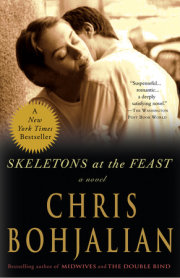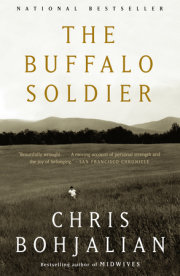Prologue
The door was presumed to have been the entry to a coal chute, a perfectly reasonable assumption since a small hillock of damp coal sat moldering before it. It was a little under five feet in height and just about four feet wide, and it was composed of barnboard and thick pieces of rough-hewn timber. Its most distinguishing feature was not its peculiarly squat visage—and if a person were predisposed to see such things in the dim light of the basement, the knobs on the wood and the character of the planking did suggest the vague shadow of a face—but the fact that at some point someone had sealed the door shut with six-inch-long wrought-iron carriage bolts. Thirty-nine of them ringed the wood and it was all but impenetrable, unless one were feeling energetic and had handy an ax. The door glowered in an especially dank corner of the basement, and the floor before it was dirt. The fact was, however, that most of the basement floor was dirt; only the concrete island on which sat the washing machine, the dryer, the furnace, and the hot-water tank was not dirt. When most prospective buyers inspected the house, this was their principal concern: a floor that seemed equal parts clay and loam. That was what caused them to nod, their minds immediately envisioning runnels of water during spring thaws and the mud that could be brought upstairs every time they did laundry or descended there to retrieve(perhaps) a new lightbulb or a hammer. It was a lot of largely wasted square footage, because the footprint of the house above it was substantial. As a result, the door was rarely noticed and never commented upon.
Still, the basement walls were stone and the foundation was sturdy. It capably shouldered three stories of Victorian heft: the elegant gingerbread trim along three different porches, which in the greater scheme of things weighed next to nothing, as well as the stout beams that weighed a very great deal but stood invisible behind horsehair and plaster and lath. Though the first-floor ceilings were uniformly twelve feet and the bedrooms' and sitting rooms' that marked the second and third floors no less than ten, the height of the basement ceiling wavered between six and eight feet, and—underneath an addition from 1927—a mere four feet. The floor rose and fell like beach sand. Further capable of inducing claustrophobia there were the immense lengths of copper tubing for gas and hot water, the strings of knob-and-tube electrical wiring (some live, some dead), and the horizontal beams that helped buttress the kitchen, the living room, and the dining room. The den. The library. The bright, wide entry hallway and the thinner, dark corridor that snaked behind the kitchen to the back stairs and the pantry. The copper tubing looped together in Gordian knots near the furnace and the hot- water tank. This piping alone scared away some buyers; it certainly scared away many more than did that door. There were strategically placed jack posts in the tallest section of the basement and a railroad tie turned vertical in the shortest.
In the years the house was for sale—one real estate agent attributed her inability to sell it to the unwillingness of the cantankerous, absentee owner to accept anything but the asking price, while another simply presumed it would take time for the right sort of family to express serious interest—all of the prospective buyers were from out of state. A great many were from Boston, enticed north into the White Mountains to see a house advertised in the Globe real estate section as the perfect weekend or retirement home for families that would appreciate its sweeping views of Mount Lafayette or the phantasmagoric foliage offered each autumn by the sugar bush to the south and the east. It was only twenty minutes from a ski resort. Still, almost no one with any familiarity with the property—and that was the right term, with its connotations of acreage (nineteen acres split between forest and meadow cut by a neighbor for hay) and outbuildings (two, including a garage that had once been a carriage barn and a small but workable greenhouse)—showed any desire to buy it. No one from the nearby village of Bethel even looked at it, viewing it as a house with (and this was the euphemism they were likely to use) a history.
At the same time, few of the agents who brought flatlanders from Massachusetts, New York, and Pennsylvania to see the house ascribed its years on the market to the door in the basement or the thirty-nine carriage bolts that sealed it shut.
* * *
When your airplane hits the flock of birds, the passengers in the cabin behind you feel the jolting bangs and the aircraft rolls fi fteen degrees to its starboard side. The birds are geese, and it is not uncommon for you to see them from the flight deck as your plane begins its climb out of Burlington, Vermont. In this particular departure corridor, you see geese, crows, seagulls (lots of seagulls), and ducks all the time. The geese are flying perhaps forty miles an hour, traveling in formation from one feeding area to another, angling south from Malletts Bay, the animals always careful to keep near their cohorts. Today your aircraft is a Bombardier CRJ700, a regional jet that seats seventy passengers, two pilots, and a pair of flight attendants. This flight has forty-three passengers and three attendants, two on duty who have been with the airline for over a decade and a half, and another who is merely commuting home to Philadelphia and has almost as much experience. Both working flight attendants are, by any standard, immensely competent. You do not know them well, but you have gotten to know them both a bit over the last four days together. Likewise, the pilots (if you may be so bold) are skilled, too, though your first officer has only been flying for three years.
(The reality is that you and Amy have not been doing your jobs as long as the flight attendants have been doing theirs.) But Amy Lynch is smart and funny, and you have enjoyed working with her the last few days, as you have flown between Washington, Pittsburgh, Charlotte, Columbus, Philadelphia, and finally Burlington. She has nearly thirty-five hundred hours of flying time, twenty-one with you over the last four days. You are a veteran who has been flying for fourteen years, and you have finally lasted long enough for there to be talk that soon you may get to start training on an Airbus simulator and begin your climb to a considerably bigger plane and a considerably bigger salary. You have twin daughters, and in eight years they will start college: That bigger paycheck matters, as does the esteem that comes with a 154-seat jet.
This afternoon you see the birds, each with a wingspan almost the length of a man, just a second after your fi rst officer does. She happens to be handling the takeoff. But the moment you fly through the drapes of geese—there it is, the sound you have always likened to a machine gun, the violent thud as each animal careens like a bullet into the metal and glass of your aircraft—the plane wobbles briefly to its side as first the left engine and then the right flame out. Most of those geese must weigh ten or eleven pounds each, and when they careen into the engines, the animals’ bones and feathers and flesh are turned almost instantly to jam and then almost as quickly incinerated. The passengers don’t know what they are smelling, but they know there is a stench in the cabin that they have never inhaled during a takeoff before, and combined with the way the aircraft has pitched to starboard, they are experiencing what even the most frequent fl yers would describe as an uh-oh sensation as they peer out the fuselage windows.
Meanwhile, you say “my airplane” and you take the controls. You flip on the APU, the backup generator in the tail of the plane, because a few years ago Chesley Sullenberger did this when his jet plowed through geese over the Bronx, and now turning on the APU is a part of the emergency checklist. You tell Amy, “Ignition on,” although you are quite sure that the wrecked blades have completely ripped the engines apart and neither will ever reignite: You can see on the instrument panel that the engine speeds are at zero. Nothing inside the turbines is spinning because whatever metal is there is now scrap and shard. But it can’t hurt to have your first officer try to restart the engines while you find the best spot to bring the plane down. “Airspeed, two hundred and forty knots,” you say, the best glide speed for this jet—the speed that will give you the longest possible glide.
And while radio communication is your lowest priority this second, you do tell the tower that there has been a bird strike. You begin with words that sound at once foreign and cinematic in your mind because you never anticipated saying them: “Burlington, we just had a bird strike and are declaring an emergency.”
“Roger. What do you need?” a cool female voice in the tower responds.
“Stand by,” you tell her simply, trying to focus. After a moment, she offers you a heading in the event you want to return to Burlington.
And, indeed, your first instinct is to make a wide, sweeping circle and land back at the airport. You left to the northwest on runway 33; perhaps you could loop back around and land on runway 15. But making a turn that large will cause the plane to lose a lot of altitude, and right now you’re only about twenty-five hundred feet in the air. You weren’t quite half a mile above the Champlain valley when that flock of geese darkened your windshield like a theater curtain. Your instincts tell you that you are never going to make it if you try for runway 15.
“Not happening,” you tell the tower. “We have no thrust in either engine.” An emergency landing at the airport is impossible.
And when you hear that voice from the tower next, you detect a twinge of panic in that usually professional façade: “Roger. State your intentions.”
You project alternate flight paths, scanning the Champlain valley.
Maybe instead of Burlington you could glide across the lake to Plattsburgh—to the airport there. The old Air Force base in upstate New York. You can see the area in the far distance to the right, and the angle of the runways looks promising. But it’s not likely you have anywhere near the altitude or the speed to make it. And even if you do coax the crippled airliner across the lake, you will still have to adjust your approach: The angle of the runways is promising, not perfect, which means you might be crash- landing in a populated area. Moreover, the CRJ has very low wings. Not a lot of clearance as you scoot along ground that isn’t a long, flat patch of pavement. It would be easy to catch a wingtip and lose control. You have seen your share of videos of planes cartwheeling along the ground into fireballs.
But you have to bring the plane down somewhere, and you have to bring it down soon. Neither engine has restarted.
You know well how that other captain managed to crash-land a powerless jet—and that was an Airbus 320, an oil tanker compared to this relatively petite CRJ—in the Hudson River one cold but crystal clear January afternoon. It was considered a miracle, but mostly it was just excellent flying. Chesley Sullenberger had flown commercially for twenty-nine years and prior to that had been a fighter jock. Twenty-nine years versus your fourteen. Arguably, a considerable difference. But you still have a boatload of hours in the air.
Likewise, you know the story of the Lockheed Electra turboprop that sailed into thousands of starlings—some people estimated as many as ten thousand—on October 4, 1960. The plane and the birds collided seconds after takeoff from Logan Airport, only four hundred feet above the water in Boston Harbor. The engines stalled and the plane plummeted into the water, no more than two hundred yards from shore. This was no gentle, seemingly slow-motion glide. There were seventy-two people onboard. Miraculously, ten survived, largely because of the flotilla of small boats that descended on the wreckage.
And now it is August, and though the sky is that same cerulean blue as it had been that January day over New York, it is downright muggy outside. Before you looms Lake Champlain, wider than the Hudson but still long like a river. You notice two ferryboats, one venturing west to Plattsburgh and the other motoring east to Burlington. There must be a dozen sailboats. And there is the crystalline surface of all that warm August water. Warm. August. Water. You will bring your plane down there—nose up so the aircraft doesn’t flip—because it is your best option. It is, perhaps, your only option. You have two dead engines and the speed of the aircraft’s descent is accelerating. You will do precisely what Sullenberger did on the Hudson. You’ve read all about it. All pilots have.
The tower is asking you again where you want to land. That voice once more brings up Burlington. She tells you that they have stopped all incoming and outgoing traffic there. Then she suggests Plattsburgh.
“I’m going to use the lake the way he used the river,” you tell her evenly, not specifying who he is because you don’t have time and, really, you were just thinking aloud when you added that to your tower communication. And already you are turning your plane from the northwest to the south and watching the water start to rise up.
You wish it were possible to dump the fuel on this CRJ, and not simply because you fear an explosion and fire; you know that the plane would float longer if there were more air in the tanks. Still, the plane should float long enough if you do this correctly. And so you descend as if you were approaching an ordinary runway, nose up, flaps full. The ground proximity warning system kicks in, and a computerized voice starts repeating, “Terrain. Terrain. Terrain.” Soon it will become more urgent, insisting, “Pull up. Pull up.” As if you didn’t know. Behind you, your passengers in the first rows hear it, too.
In a moment you will give the command every captain dreads: “Brace for impact.” Then you will skim across Lake Champlain, landing from the north a few minutes past five on a summer afternoon, and your passengers will be rescued by those ferryboats and sailboats. They will not face the frigid waters of the Hudson River but will instead wait on the wings in the gentle summer bath of a New England lake or bob on the waves in those garish orange life rafts.
“Thrust levels all idle,” Amy tells you, shaking her head, just a trace of anxiety in her usually giddy, usually playful voice.
Without thrust, landing the plane will be all about pitch. Lowering the nose will give you more speed and a longer glide; raising it will slow the aircraft and shorten your time in the air. You want to belly into the lake as gently as possible, though gentle is a relative term. The water can feel like granite to the underbelly of a jet if you hit it at the wrong angle.
“No relight,” Amy tells you, essentially reiterating what she shared with you just a moment ago, speaking louder now because, in addition to having to be heard over the synthetic Cassandra telling you to pull up, pull up, pull up, your flight deck is alive with emergency chimes and bells and a controller who wants you in Burlington or Plattsburgh or (Did you hear this correctly?) the interstate highway in New York that runs parallel to the lake. But the asphalt linking Albany and Plattsburgh is no more an option than the asphalt on the runways at the airports on either side of the water. No, you will use the lake the way Chesley Sullenberger used the river, and soon your passengers will be wrapped in blankets on the decks of the ferries.
* * *
The plane is eighteen rows long along one side but only seventeen on the other so there is room for a second lavatory at the front of the aircraft. There are two doors at the front of the plane and two over the wings at row fourteen (though that is actually the unnamed thirteenth row). Everyone in the passenger cabin is agonizingly aware of their proximity to those four exits, but perhaps no one is more focused upon them right now than Ethan Stearns as he sits in an aisle seat in the very last row, barely a foot and a half from the rear lavatory. It is not his own safety that has him calculating in his mind the speed with which he will be able to fi ght his way through the chaotic, merciless swarm to those exit windows, assuming the plane actually remains intact after it hits the surface of the lake; it is the safety of his young daughter, Ashley, who is sitting in the window seat beside him. His wife, Ashley’s mother, is ten rows ahead of them. The plane is not full, but it seemed like a lot of work to have the gate agent reassign their seats so they could be closer together on the short trip to Philly. So, instead of his wife in the row ahead of him, there is a man he knows nothing about and a woman who, based on something she said into her cell before the doors were locked and armed, had just interviewed at the IBM facility in Essex Junction, Vermont.
His wife, he realizes, is five rows from the exits over the windows and just seven from the front doors of the plane. He and Ashley are five rows from their only real shot from the aircraft, the window exits. His mind has already done the triage and the odds: His wife is more likely to survive than either he or their eight-year-old daughter. His eyes meet his wife’s when she turns back to glance at Ashley and him. He smiles; somehow, he smiles. He reminds himself as he gazes around his lovely little girl’s head—which is pressed so close against the glass that he can barely see out of it—that the guy who landed an Airbus in the Hudson got everyone out alive. It’s not like they’re about to slam into a mountain or a skyscraper. He makes sure that her life jacket is tight around her waist and he understands how to inflate it once they are outside the plane. He had barely had time to find it under her seat and figure out how to pull it from its bag and unfold it. He never did find his. He guesses no more than three or four other passengers have donned life jackets.
“Brace for impact!” the flight attendant is telling them. “Brace for water landing! Heads down, heads down, heads down!”
“When we come to a stop in the water, we are going to race for that window exit,” he tells his girl gently, whispering into her ear, trying to sound as serene as the flight attendant sounds urgent. “Okay? I am going to lift you up and carry you like we’re racing through the crowds on Main Street in Disney World. You remember, when the park’s closing for the night after the fireworks and we’re racing for spots on the monorail?”
“But I can’t swim that far,” she stammers, her voice a little numb.
“That’s why you have a life jacket,” he tells her. “The key is to scoot out of the plane with me, that’s all. Your mom will already be waiting for us because she’s a little closer to the exit.” Then his eyes go back to his wife’s, and her terror is like an electric shock. The cabin is eerily quiet because the engines aren’t working, and the passengers are mouthing their prayers or texting or staring in mute wonder as the plane seems to be descending beneath the Burlington skyline to the east and the Adirondack foothills to the west.
“Do not wait for us!” he finally says to his wife, uncaring that it is like shouting in a cathedral during silent prayer. “I’ll have Ashley! Just get out of the plane!”
Once he has spoken, broken the spell, others start offering advice. Someone, a man, yells for the women and men in the exit rows to be prepared. Someone else starts yelling out how many feet above lake water he believes they are.
Ethan finally pulls his daughter's head from the window, kisses her on the cheek, and then pushes her down into the brace position. Then he joins her, but he wraps his left arm around her shoulders, as if he actually believes he is strong enough to protect her from the impact of a passenger jet augering into a lake at 150 miles an hour.
* * *
The captain never thought the door in the basement in any way resembled the over-wing exit doors on an airplane. Or even a main cabin door. Which, of course, it did not. But much later his new therapist, when the captain and his family had moved from Pennsylvania to New Hampshire, would probe this connection. A squat door? A pilot with PTSD? How could a psychiatrist not mine this possible connection? But of all the things the captain saw in the door in that dusky corner of the basement in the house they had bought, a locked and armed passenger jet door was never among them.
Copyright © 2011 by Chris Bohjalian. All rights reserved. No part of this excerpt may be reproduced or reprinted without permission in writing from the publisher.

































